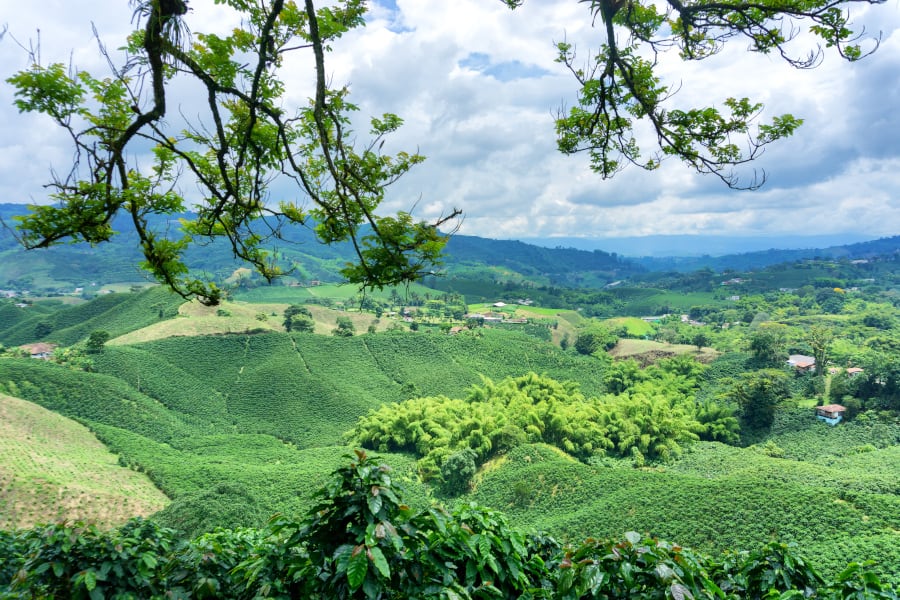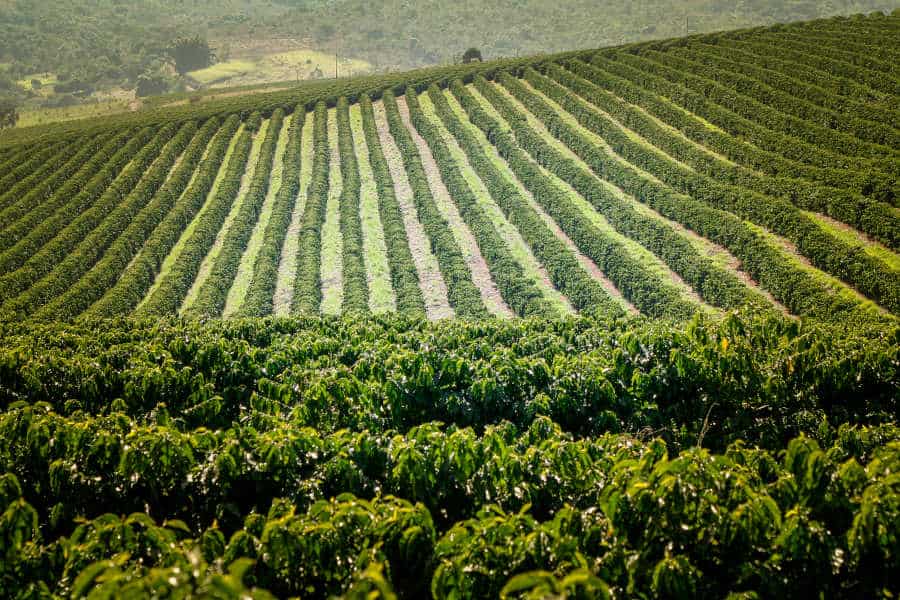Most people associate Latin America with coffee, as it’s generally known that ideal conditions for growing coffee are in Latin America. Still, you’d be wrong to disregard many other countries with great coffee. This beverage has been a favorite for generations, and people have been drinking it almost religiously for centuries now.
However, different coffee beans offer different tastes. Many things determine the difference between coffee beans. The climate is one of the most critical elements that determine the taste of the coffee. That’s why different countries have such great varieties of taste.
In today’s article, we’ll be taking a look at the countries with the best coffee beans in the world.
Let’s get started!

Colombia
Everyone probably knew that this was coming, so let’s just get it out of the way. Shakira and coffee are two things everyone associated with Colombia, known for growing great coffee beans. Colombia is so prominent in this industry that they produce 15% of the world’s coffee supply. Can you imagine that? A single country producing 15% of the world’s complete supply of a single product? Incredible.
Arabica, Supremo, Extra, and Excelso are the most popular types of coffee leaving Colombia. Supremo is most often considered the best one out of the four, with Arabica being a world-renowned coffee. The reason Supremo is so highly rated is that it’s processed using the latest technology, and it’s available in large and smooth grains. At the same time, it also possesses a vibrant flavor with a velvety aroma. Genuine Supremo coffee beans from Colombia are difficult to come by as it’s rare and costly.
Extra is an excellent sort of coffee, and it’s also rated very highly among coffee lovers. It’s just slightly smaller than a bean of Supremo coffee, but it’s very strong and energizing.
Excelso, on the other hand, is a mixture of Supremo and Extra, and it’s often reminiscent of wine.
Colombia produces millions of bags a year. For example, the country produced 11 million bags of coffee beans in 2013, enormous.
Colombia is very close to the equator. The direct consequence of that is the country having two harvests a year instead of one. This ensures that they produce more coffee than any other country, barring Brazil.
If you’re interested in Colombian coffee, you can try other micro-flavors from smaller producers. These people are growing, harvesting, processing, and drying themselves (many producers outsource those jobs to various other mills), ensuring that the taste of coffee is unique and truly genuine.
Coffee had a relatively long history in Colombia, as it arrived there in the 1700s. Still, it would take 100 years more before it became such a culturally significant lifestyle aspect. In the first decade of the 19th century, coffee spread so fast as coffee seeds were distributed and planted all over the country, which caused coffee to become a widespread crop in Colombia.
In 1927, Colombia launched “Federación Nacional de Cafeteros de Colombia” – National Federation of Coffee Shops in Colombia – and that organization took the lead in coffee research and development, which caused their market to boom and became stronger than Brazil and Vietnam.
The only country that produces more coffee yearly is Brazil, which takes us to our next entry on this list. However, Brazil is much larger than Colombia, and the country has so much more space for coffee production.

Brazil
Brazil had the upper hand over Colombia as their first coffee plantations started sprouting out in the 18th century, a century before Colombia made the same move. And there’s a whole legend behind it! The seeds were even smuggled to Brazil – a diplomat supposedly seduced a Portuguese governor’s wife and secretly gave him a bouquet topped with coffee seeds.
Brazil produces almost 50 million bags a year, which puts the country on the very top of the list (at least by quantity). Since the country is large, there are many different microclimates, leading to unique and distinctive flavors. In this diversity, there are four distinct processing methods that were developed to process coffee, which only adds to different tastes of coffee.
Brazil was producing nearly 30% of the world’s whole coffee supply by 1820, and by 1860 it was producing almost 80% of it because Africa and Asia were facing major coffee plant diseases.
Brazilian coffee flavors are often considered underrated, as most people only purchase Brazilian coffee to make espressos. However, this country produces specialty-grade coffees, and that can’t be looked over. Brazilian coffee is described as possessing an intense sweetness in the form of caramel and chocolate notes, and it’s low in acidity, so it doesn’t have that winey aftertaste.
Brazil has fourteen major coffee-producing regions spread over seven states, and that ensures diversity in their coffee. Minas Gerais (Sul de Minas, Cerrado Mineiro, Chapada de Minas, Matas de Minas), São Paulo (Mogiana, Centro-Oeste), Espírito Santo (Montanhas do Espírito Santo, Conilon Capixaba), Bahia (Planalto da Bahia, Cerrado da Bahia, and Atlantico Baiano), Paraná (Norte Pionerio do Paraná), Rondonia, and Rio de Janeiro are just some of the places you might be getting your coffee from, and each one of these places has completely different cultures surrounding coffee.
Bourbon, Mundo Novo, Icatú, Catuaí, Iapar, and Catucaí are just some Brazilian coffee flavors you can try.
Most Brazilian coffee is either natural or pulped natural. Natural means that after the coffee cherries are picked, they are dried as theyare – without removing skin or mucilage. Brazil’s climate makes the country perfect for natural processing because of very little rainfall and many hours under the sun.
Brazil also has a very highly detailed classification system. Screen, sorting, color, and cupping are elements that determine just how good coffee is, while it’s sorted into strictly soft, soft, softish, hard, riada, rio, and rio zona. (from best to worst)
Brazil’s coffee culture is an immensely developed one, and anyone who overlooks it when deciding what coffee to choose is making a mistake.
Ethiopia
Some experts consider Ethiopian coffee to be the best in the world, and it’s the fifth-largest coffee producer in the world. Ethiopia is producing 3-5% of the world’s coffee each year. Coffee is the heart of the Ethiopian agricultural economy, and it’s their top product.
Ethiopia is the birthplace of Coffea arabica, the coffee plant. According to legend, a goat herder saw his goats nibble on some beans and become very energized afterward, all the way back in the 9th century, and that’s how coffee became so popular in Ethiopia, later spreading to the rest of the world. Nowadays, coffee makes up 28% of Ethiopia’s foreign export earnings.
Alem Buna is one of the most popular coffee shops of Ethiopian coffee – it makes for a much more powerful macchiato than the ones seen in western countries. It is said that coffee is made in a completely different way here, a practice that preserves the caffeine much more, so you’re energized much more from this coffee than from its counterparts, which can be found worldwide. The coffee we usually drink is even less potent.
Coffee is an integral part of Ethiopian culture, as a simple coffee cup has been elevated to crucial cultural significance. Like Chinese traditions with tea, Ethiopians have their habits of preparing, serving, and drinking coffee. A ceremony leader roasts coffee beans in front of guests while puffing smoke throughout the room. They do it with either sugar or salt, something that’s very uncommon in western societies. They also serve popcorn with coffee and burn frankincense.
They traditionally serve coffee in local “jebena bets” – small huts with tin roofs where coffee is brewed in clay pots.
Kenya
Most experts list Kenyan coffee alongside Ethiopian coffee as the best in the world. Rich body and high acidity accompanied with intense flavor and delightful aroma, it should be no wonder so many people appreciate this coffee. Kenyan coffee is known for its berry undertones and in-your-face acidity, with the black current being a distinct Kenyan flavor – that only adds to the uniqueness of Kenyan coffee.
Coffee is grown at an altitude of over 6,000 feet (asl) in Kenya, an elevation that enables it to develop its complex flavors. Since Kenya is sitting on the equator and is surrounded by mountains, the low oxygen and cooler temperature slow the coffee fruit’s growth, which allows for the desired floral and fruity flavors to develop. Interestingly enough, Kenyan marathon runners also give credit to these same conditions, as they’re mainly at fault for building endurance.
The rich volcanic soil is fertile and only adds mineral nutrients to enhance the flavor of the coffee. This also allows for the coffee to grow naturally without the need for extensive use of fertilizers and pesticides, unlike other coffee-growing cultures around the world.
Something that also adds a lot of value to Kenyan coffee is the fact that it’s handpicked by Kenyan farmers, who only the red ripe cherries from the trees and carefully sort out any with defects. This is very time consuming, but it only ensures that the coffee is excellent in value. Other countries focus on a more mechanized coffee production, where machines strip the whole tree of beans. Still, in Kenya, that’s not a common practice, and coffee lovers widely appreciate that.
Unripe coffee usually results in an odd taste in the mouths of drinkers, similar to any unripe fruit’s taste. This unique history of Kenyan coffee farms maintains the high quality of the coffee that’s produced.
This coffee also goes through the fermentation process to create the flavor you can taste. That’s very similar to grapes that go through fermentation to produce wine. Numerous methods are used in processing coffee, and they are usually identified by specialty coffee roasters as wet-processed, natural-process, or honey-process. They sometimes even ferment the coffee twice and rinse it with clean water, which adds to the clarity and brightness of flavors unique to Kenyan coffees.
All Kenyan coffee beans are Arabica beans, and they come in different varieties: SL28, SL34, K7, Ruiru 11, and Baitan.
Of course, there’s a difference between all of these, as SL28 is a medium to high-elevation coffee bean, and it requires much less rain than SL34. K7, on the other hand, is very immune to diseases, but it isn’t as nearly as good as the sorts mentioned above.
However, Ruiru 11 and Batian sorts combine both, and they can build you immunity while tasting great!
Lastly, it’s interesting that Kenyans don’t drink the coffee they produce. Funnily enough, Kenya is a tea-drinking country, while Ethiopia is the one drinking coffee. Kenyans drink only a fraction of the coffee they produce, and it’s produced in Ruiri, Thika, Kirinyaga, Mt. Kenya West, Nyeri, Kiambu, and Muranga.
Guatemala
Despite being significantly smaller than Colombia, Guatemala still produces magnificently large amounts of coffee, and their coffee can undoubtedly hold up with other high-quality sorts.
Guatemalans started producing coffee in the late 18th century, but they didn’t start to export it worldwide until the late 19th century. Then, European immigrants launched grand scale plantations and started to export coffee all around the world.
By 1859, over a half million coffee trees had been planted around Coban, Antigua, Fraijanes, and San Marcos. Exporting coffee quickly became the backbone of the Guatemalan economy, and Justo Rufino Barrios, their dictator at the time, had virtually eliminated communal ownership of land in Guatemala. In the late 19th century, coffee made up 90% of Guatemala’s exports! It remains their largest export to this day.
However, the story of coffee in Guatemala takes a darker turn, as it’s now reported that they’ve been facing incredible levels of corruption, debt, and exploitation of workers, all influenced mainly by the Civil war that had happened. The production of coffee in Guatemala largely depends on the influx of migrant workers.
Guatemalan coffee beans make some of the best coffees in the world. Antigua Santa Barbara is one of those sorts, and it’s the poster coffee for Central American coffee. This sort has notes of chocolate and nuts, with velvet and cream. It’s very acidic and sweet, like candy to balance the flavor profile. The sweet finish of the coffee will leave a sweet aftertaste in your mouth after drinking it.
The aroma of this coffee is very complex and very strong, so it’s undoubtedly going to leave the room smelling nice after you’ve finished drinking your coffee.
Organic Huehuetenango is another sort that must be mentioned. Low-acid coffees are generally treated as coffees that are too bitter and taste almost like they were burnt, as they don’t have the light, bright acidity that balances the coffee’s toastier notes – this sort is the exception to that rule, though. This sort is very smooth and very rich, offering a caramel-like sweetness with notes of fruit and chocolate and a bright flavor.
San Marcos is the last Guatemalan coffee we’ll mention, and it’s a nut-oriented flavor that’s light on the taste buds. San Marcos dominates a full-bodied coffee with a smooth taste with the flavor of nuts in the taste and aftertaste!
Rwanda
Something unprecedented about Rwandan coffee is the fact that they were producing no specialty coffee just two decades ago. Nowadays, however, they’re hosting a Cup of Excellence competition, and the quality of their coffee has increased a lot in the last few years. Unfortunately, they aren’t producing vast amounts of coffee like Kenya and Ethiopia, but the quality of coffee is par.
They started producing coffee relatively late, at the beginning of the 20th century, but it would take three decades for the production to take flight. The types of coffee beans grown in Rwanda were relatively low-grade, mostly because of the government’s harsh demands before the country gained independence.
Rwanda nowadays exports dozens of millions of coffee a year, and the largest part of this comes from small farms rather than larger estates. Most of the plantations in the country are relatively high, between 4,000 and 6,500 feet (asl). Unlike Kenya, these plants are not just Arabica but have varieties in sort.
The wet processing of coffee combined with the small estates that produce it doesn’t allow for large, individual washing stations like the great coffee estates throughout the world do.
All sorts of Rwandan coffee have hints of orange and lemon in aroma, with floral tastes mixed with fruity, redcurrant, berry flavors. The aftertaste is often reminiscent of caramel and white chocolate.
Lighter roasts of Rwandan coffee can yield a much more acidic, fruitier flavor profile, and that’s something a lot of people can appreciate. In contrast, the darker roasts accentuate the body.
The western regions of the country are considered the capital of the Rwandan coffee industry, and they’re filled to the brim with plantations. In the east, however, the largest part of the land is a national reserve, so the only coffee-growing exception is around Lake Kivu. The coffee is grown there; however, it is truly exceptional.
The heights there are enormous, and the coffee grown there is incredibly complex, often including a profile with hints of sweet orange, cherry, lime, and cocoa.
Panama
This is the last entry on the list, but certainly not the least important one.
Panama has a desirable climate for cultivating coffee plants. Over 80% of the coffee grown there is Arabica, while a smaller, 20% yield is Robusta produced in low-altitude regions, including Coclé, Panamá Oeste, Colón, and others.
The Chiriquí province, with its mountain highlands, provides the perfect conditions for Arabica. This coffee is mostly exported, while Robusta is grown for primarily local consumption. Panama usually consumes some 20 million kilograms of coffee a year – five kilograms per capita, which is very high compared to other countries.
The three main coffee-growing areas in Chiriquí are Boquete, Tierras Altas, and Renacimiento. A stratovolcano called Volcán Barú littered the soil when it erupted almost 500 years ago, littering the soil with tephra. This makes the soil rich and fertile nowadays, which makes it ideal for growing coffee. You would find more details on the most prolific areas in our post from Best of Panama Auction.
The country’s unique weather conditions are also a massive bonus for growing coffee, as there are over 100 microclimates in Panama, with the weather varying from region to region. All of this allows Panama to produce many different sorts of coffee, including Catuai, Caturra, Maragogype, Pacamara, and Mundo Novo. Geisha, however, is the sort of coffee that’s associated with Panama the most.
** We have an article exclusively about Pacamara in case you want more details about it.
** We also have an article about Caturra here, in case you want more information about this bean variety.
This variety, however, actually originated in Ethiopia and only came to Panama in the 1960s. Many people fell in love with it because of its sweetness and bright acidity, often accompanied by a fruity and floral aroma.
The consumption of specialty coffee was minimal in Panama before the millennium, but the number of specialty coffee shops has only risen since then! Panama has a very bright future in the world of coffee, and you shouldn’t sleep on it!
